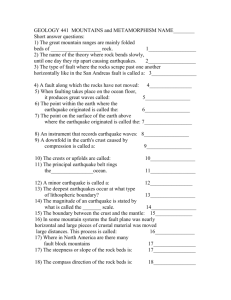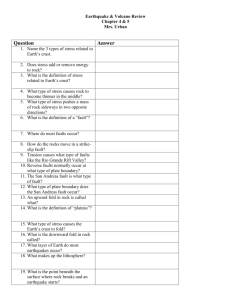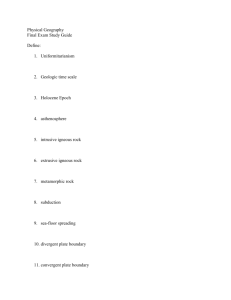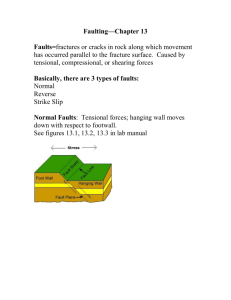Final Exam: end of year Review Sheet #1 - H
advertisement
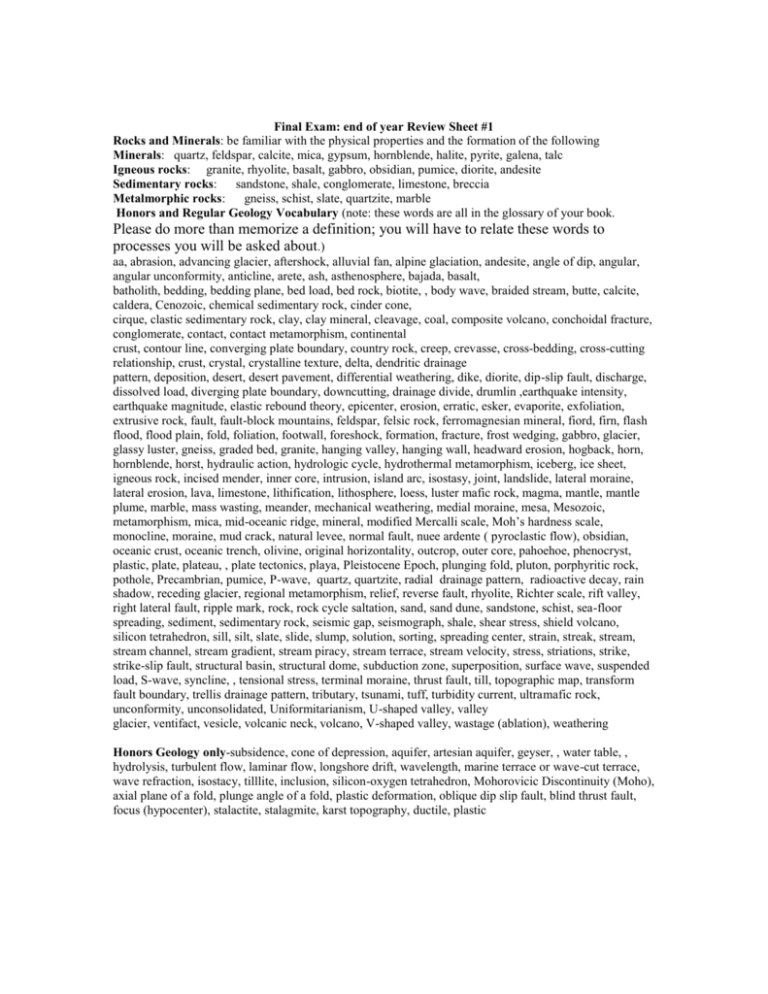
Final Exam: end of year Review Sheet #1 Rocks and Minerals: be familiar with the physical properties and the formation of the following Minerals: quartz, feldspar, calcite, mica, gypsum, hornblende, halite, pyrite, galena, talc Igneous rocks: granite, rhyolite, basalt, gabbro, obsidian, pumice, diorite, andesite Sedimentary rocks: sandstone, shale, conglomerate, limestone, breccia Metalmorphic rocks: gneiss, schist, slate, quartzite, marble Honors and Regular Geology Vocabulary (note: these words are all in the glossary of your book. Please do more than memorize a definition; you will have to relate these words to processes you will be asked about.) aa, abrasion, advancing glacier, aftershock, alluvial fan, alpine glaciation, andesite, angle of dip, angular, angular unconformity, anticline, arete, ash, asthenosphere, bajada, basalt, batholith, bedding, bedding plane, bed load, bed rock, biotite, , body wave, braided stream, butte, calcite, caldera, Cenozoic, chemical sedimentary rock, cinder cone, cirque, clastic sedimentary rock, clay, clay mineral, cleavage, coal, composite volcano, conchoidal fracture, conglomerate, contact, contact metamorphism, continental crust, contour line, converging plate boundary, country rock, creep, crevasse, cross-bedding, cross-cutting relationship, crust, crystal, crystalline texture, delta, dendritic drainage pattern, deposition, desert, desert pavement, differential weathering, dike, diorite, dip-slip fault, discharge, dissolved load, diverging plate boundary, downcutting, drainage divide, drumlin ,earthquake intensity, earthquake magnitude, elastic rebound theory, epicenter, erosion, erratic, esker, evaporite, exfoliation, extrusive rock, fault, fault-block mountains, feldspar, felsic rock, ferromagnesian mineral, fiord, firn, flash flood, flood plain, fold, foliation, footwall, foreshock, formation, fracture, frost wedging, gabbro, glacier, glassy luster, gneiss, graded bed, granite, hanging valley, hanging wall, headward erosion, hogback, horn, hornblende, horst, hydraulic action, hydrologic cycle, hydrothermal metamorphism, iceberg, ice sheet, igneous rock, incised mender, inner core, intrusion, island arc, isostasy, joint, landslide, lateral moraine, lateral erosion, lava, limestone, lithification, lithosphere, loess, luster mafic rock, magma, mantle, mantle plume, marble, mass wasting, meander, mechanical weathering, medial moraine, mesa, Mesozoic, metamorphism, mica, mid-oceanic ridge, mineral, modified Mercalli scale, Moh’s hardness scale, monocline, moraine, mud crack, natural levee, normal fault, nuee ardente ( pyroclastic flow), obsidian, oceanic crust, oceanic trench, olivine, original horizontality, outcrop, outer core, pahoehoe, phenocryst, plastic, plate, plateau, , plate tectonics, playa, Pleistocene Epoch, plunging fold, pluton, porphyritic rock, pothole, Precambrian, pumice, P-wave, quartz, quartzite, radial drainage pattern, radioactive decay, rain shadow, receding glacier, regional metamorphism, relief, reverse fault, rhyolite, Richter scale, rift valley, right lateral fault, ripple mark, rock, rock cycle saltation, sand, sand dune, sandstone, schist, sea-floor spreading, sediment, sedimentary rock, seismic gap, seismograph, shale, shear stress, shield volcano, silicon tetrahedron, sill, silt, slate, slide, slump, solution, sorting, spreading center, strain, streak, stream, stream channel, stream gradient, stream piracy, stream terrace, stream velocity, stress, striations, strike, strike-slip fault, structural basin, structural dome, subduction zone, superposition, surface wave, suspended load, S-wave, syncline, , tensional stress, terminal moraine, thrust fault, till, topographic map, transform fault boundary, trellis drainage pattern, tributary, tsunami, tuff, turbidity current, ultramafic rock, unconformity, unconsolidated, Uniformitarianism, U-shaped valley, valley glacier, ventifact, vesicle, volcanic neck, volcano, V-shaped valley, wastage (ablation), weathering Honors Geology only-subsidence, cone of depression, aquifer, artesian aquifer, geyser, , water table, , hydrolysis, turbulent flow, laminar flow, longshore drift, wavelength, marine terrace or wave-cut terrace, wave refraction, isostacy, tilllite, inclusion, silicon-oxygen tetrahedron, Mohorovicic Discontinuity (Moho), axial plane of a fold, plunge angle of a fold, plastic deformation, oblique dip slip fault, blind thrust fault, focus (hypocenter), stalactite, stalagmite, karst topography, ductile, plastic GEOLOGY REVIEW SHEET Part 2 This review sheet covers the material studied in the second semester. 1. What conditions result in rockslides and flows? 2. How can mass wasting be avoided? 3 Distinguish among the various kinds of mass wasting 4. What causes drainage to be radial, trellis, or dendritic 5. What factors affect the velocity of a river? 6. How can you determine a river's discharge? 7. What is alluvium, and in what ways does it differ from till and wind deposits? 8. Describe the process of stream piracy. 9. At what points in a rivers evolution does it erode by downcutting, headward erosion, and by lateral erosion? 10. Describe the formation of an oxbow lake, of a water gap, and of entrenched meanders. 11 What are the features that distinguish a young, mature and old age river? 12. How does the stream valley of a river change as it matures? 13. How is a delta formed? 14 How does porosity differ from permeability? 15. How do valley (alpine) glaciers differ from continental glaciers? 16. What causes a glacier to move, to advance, to retreat? 17. What features are formed by glacial erosion? 18. What are the causes of the Pleistocene Ice Age 19. What two factors influence the distribution of the world's deserts? 20. How are playa lakes formed? 21. What causes crossbedding in sandstone? 22. What is loess? 23. Distinguish among normal, reverse, thrust, and strike-slip faults. 24. What is the strike and dip of a rock layer, and how do you measure them? 25. Distinguish among the following geologic structures: syncline, anticline, dome, basin, plunging anticline, plunging syncline 26. Do rocks dip towards or away from the youngest rock layer? 27. Where would you look to find oil? 28. How are fault-block mountains formed? 29. What is an angular unconformity? 30. What kinds of waves are given off by an earthquake? 31. What causes earthquakes? 32. Describe a typical pattern of aftershocks. 33. How doe the following faults differ from each other, and give an example of a specific earthquake on each kind of fault. a. right lateral strike slip fault b. thrust fault c. blind thrust fault 34 . Why does Los Angeles have more faults than San Francisco? 35. What is the difference between the epicenter and the hypocenter of an earthquake? 36. How is the location of the epicenter of an earthquake determined? 37. What is the intensity and magnitude of an earthquake, and how are they measured? 38. What is a tsunami? 39. How do limestone caverns form? 40. What features would indicate that a coast was emergent or subsiding? 41. How does a geyser work? 42. What is an aquifer, and what kinds of rock make a good aquifer? 43. During the Miocene, California changed from a convergent boundary to a transform fault boundary. Describe the changes that occurred in the landscape and the rock formations. 44. How does oil form? 45. How is oil mined? 46. How does coal form 47. How is coal mined?
